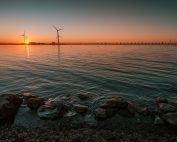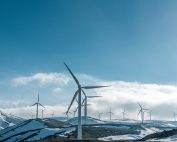We spoke to Łukasz Piotrowicz, Offshore Development Manager at Iberdrola, about the main challenges in the market, how to meet growing demand within supply chains, the potential of the Baltic market, as well as key technologies that will drive innovation in the offshore sector.
BalticWind.EU: What are the main challenges Iberdrola sees for the offshore wind sector in the context of the very ambitious plans to reach 111 GW in EU countries by 2030 (according to the EU Wind Power Package)*?
Łukasz Piotrowicz, Offshore Development Manager, Iberdrola: We are very positive about the European Commission’s approach to the development of wind energy as a key element of decarbonisation. It is a very ambitious plan, as the Commission itself points out, this means about 12 GW of new installed offshore wind capacity in Europe per year. This is 10 times more per year than wat was installed in 2022. Reaching this level means significantly accelerating the implementation of projects at all stages. This also means a significant increase in the volume of deliveries of components and, consequently, in the volume of supplies of raw materials necessary for production, including critical raw materials. One of the main immediate challenges will be the readiness of the necessary infrastructure, for example power grids and port infrastructure.
Another problem might be the access to right number of raw materials, global factors have a direct impact here. Of course, the readiness of the supply chain, including the availability of the installation fleet, will be equally crucial. Competition between markets in the world, i.e., between the European and American markets, may play a role here.
The degree of complexity and duration of the procedures for issuing permits, opinions and administrative arrangements is a regional factor on which we have a direct influence. We find the fact The European Commission recognises these risks and is already taking action to mitigate these challenges, for example through the proposal for the Critical Raw Materials Act. It will be important to maintain the pace of work on the implementation of appropriate tools to mitigate these risks and to keep productive dialogue with all stakeholders.
Are European supply chain companies for the offshore wind sector able to meet the growing demand?
Unexpected and very dynamic changes in the world directly and indirectly affect the readiness of European supply chain companies to meet the growing demand. We can also observe this in other technologies of electricity production and in other industries, e.g., in the automotive industry. Taking the above into account, this is one of the significant challenges for the implementation of offshore wind farms in our region.
Here it is worth referring again to the actions of the European institutions. As you can see, the risk is recognized by all stakeholders, including the European Commission. The answer is to support European industry, for example the Net Zero Industry Act. Such mitigation measures are very important, and we are glad that they are being implemented with the right momentum. There is also concern about the increasing share of supplies from other regions of the world, primarily from China.
Experts see the need to change the approach and treat the entire European industry as a form of the local content. They talk about the necessity for cooperation amongst the EU markets and mutual support, of course, while maintaining the principles of competitiveness. The role of the European institutions and the national authorities is very important here – through direct action and, above all, by establishing clear, sensible strategies for the development of wind energy linked to strategies for other sectors.
Which technologies will be key to effectively develop offshore potential in Europe?
The effective development of offshore potential in Europe will require the use many innovative and state of the art technical solutions while maintaining project cost-effectiveness, standardisation, and scalability. Here, it is simply required to maintain the tradition of this industry, which has been the spiritus movens of innovation in the industry since its beginnings.
Indicating these key technologies, it is necessary to start with the supply of electricity, i.e., the development of offshore wind connections with the direct current technology, the development of offshore energy islands or connection hubs.
A new approach to foundations will be necessary due to the growing challenges related to the increasing depth of farm areas, the complex structure of the bed sea, but also the mechanical loads of increasingly large wind turbines. As well as the development of floating wind farm technology in the next stage.
Further, the direct link between offshore wind farms and energy storage and hydrogen production.
The growing share of unmanned surface water, underwater and air vessels in the maintenance and installation of these projects will also be important. It is also worth mentioning the technical solutions that ensure increased safety of farms against growing external threats.
How does Iberdrola see the potential of the offshore market in Poland and other Baltic Sea countries?
We are present in the Baltic Sea, and we know it’s conditions very well. Iberdrola is the operator of the Wikinger wind farm with a capacity of 350 MW. We have also successfully installed all fifty monopiles for the Baltic Eagle offshore wind farm, which is the second of the large projects being implemented in the German waters of the Baltic Sea. A third Windanker project, with a capacity of 315 MW, is under development and is scheduled for completion in 2026. Together, these three offshore wind farms form Iberdrola’s so-called Baltic Hub.
The potential of the Baltic Sea, including the Polish part, is greater than what has been allocated so far in concessions. In the PWEA’s analysis, Poland’s offshore wind capacity is amounted to 33 GW. We will therefore consider participating in a potential third phase in the future.
What role do you want to play in these markets?
We are constantly working on expanding our portfolio of offshore projects. At the end of September 2023, Iberdola’s offshore wind grew by 28.6%, to 1,618 MW. We also plan to invest more than €8 billion in this sector by 2025. Our offshore wind capacity will reach 3,100 MW by 2025 and 4,800 MW in 2026/27.
Recently, Iberdrola connected to the grid offshore wind farm Saint-Brieuc constructed in the waters of Brittany, France. It is the first large-scale offshore wind project in Brittany and the second in France to produce clean energy.
We are probably the largest offshore wind developer in the Baltic Sea. We have not obtained a location permit for the construction of an offshore wind farm in the Polish part of the Baltic Sea, as have other foreign investors, but we maintain our interest in this area.
It cannot be ruled out that the companies that obtained the permits in the second phase will look for partners. We will monitor the situation, especially since there will be a change of the government and we will see what decisions the new government will make.
What are the main challenges facing the Polish market?
One of the main bottlenecks in RES investments, regardless of technology, is the grid connection. The data shows that up to 90 per cent of applications for connections are rejected. This is also a significant risk for the development of offshore wind farms. Now, the capacity planned by PSE in the National Power System is 10.9 GW for the connection of the offshore wind farm, compared to 17.9 GW of capacity at the locations from the first and second phases combined. There are announcements of large investments in networks, so we hope that the situation will improve.
To this should also be added the subject of maritime spatial planning, both in terms of locating new areas for offshore energy and planning corridors for submarine cables connecting wind farms with onshore connection points. Maybe it is worth going back to the concept of a maritime network and using the ideas that have already been developed.
Given the planned scale of offshore wind development in Poland, it is necessary to strengthen the state and local government administration, which will bear a significant burden of conducting numerous administrative procedures. And in terms of the legal regulations themselves, it is worth introducing several optimisation measures to make these procedures more flexible and realistic. For example, the rules for connecting to the Grid and settling production from offshore wind farms. As well as the introduction of the possibility of implementing energy storage or hydrogen technologies as part of the implementation of offshore wind projects.
It will also be a challenge to recruit the right staff and prepare specialists in the country. Bottom-up activities of individual organisations, which are in a way very important and ambitious, are not enough. To achieve this, we need to change and update the education system along with the core curriculum. After all, we are talking about a comprehensive, broad industrial and economic transformation on a national scale.
We know that the supply chain is a global challenge. At the same time, we know that local industry has the potential to participate in this market in our country. Appropriate planning and support activities at the national level can significantly help in the preparation of the Polish industry and thus reduce the risk of delays in the supply of materials, components, or services.
The key to these challenges will be the cooperation of all the market players and, above all, a constructive and open dialogue between the participants of the offshore wind industry and the government.















